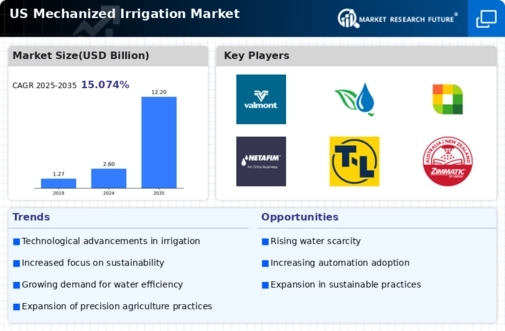The mechanized irrigation market in the US is characterized by a dynamic competitive landscape, driven by technological advancements and increasing demand for efficient water management solutions. Key players such as Valmont Industries (US), Rain Bird Corporation (US), and Lindsay Corporation (US) are at the forefront, each adopting distinct strategies to enhance their market positioning. Valmont Industries (US) focuses on innovation through the development of advanced irrigation systems that integrate IoT technology, thereby improving water efficiency and crop yield. Meanwhile, Rain Bird Corporation (US) emphasizes sustainability, offering products that reduce water consumption while maximizing agricultural productivity. Lindsay Corporation (US) is also notable for its strategic partnerships aimed at expanding its product offerings and market reach, which collectively shapes a competitive environment that prioritizes technological integration and sustainability.
The business tactics employed by these companies include localizing manufacturing to reduce costs and optimize supply chains, which is particularly crucial in a moderately fragmented market. This competitive structure allows for a diverse range of products and services, enabling companies to cater to various agricultural needs across different regions. The collective influence of these key players fosters an environment where innovation and efficiency are paramount, driving the market forward.
In August 2025, Valmont Industries (US) announced the launch of a new line of smart irrigation systems designed to leverage AI for real-time data analysis and decision-making. This strategic move is significant as it positions Valmont as a leader in the integration of AI technology within irrigation solutions, potentially enhancing water conservation efforts and operational efficiency for farmers. The introduction of such advanced systems may set a new standard in the industry, compelling competitors to innovate further.
In September 2025, Rain Bird Corporation (US) unveiled a partnership with a leading agricultural technology firm to develop a comprehensive water management platform. This collaboration aims to provide farmers with data-driven insights to optimize irrigation schedules and reduce water waste. The strategic importance of this partnership lies in its potential to enhance Rain Bird's product offerings, aligning with the growing trend towards digitalization in agriculture and reinforcing its commitment to sustainability.
In October 2025, Lindsay Corporation (US) expanded its operations by acquiring a regional irrigation company, thereby enhancing its market presence and product portfolio. This acquisition is strategically important as it allows Lindsay to tap into new customer segments and leverage existing distribution networks, which could lead to increased market share and revenue growth. Such moves reflect a broader trend of consolidation within the industry, as companies seek to strengthen their competitive positions through strategic acquisitions.
As of November 2025, the mechanized irrigation market is increasingly defined by trends such as digitalization, sustainability, and the integration of AI technologies. Strategic alliances are becoming more prevalent, shaping the competitive landscape by fostering innovation and collaboration among key players. Looking ahead, competitive differentiation is likely to evolve, with a shift from price-based competition to a focus on technological innovation, supply chain reliability, and sustainable practices. This transition underscores the importance of adaptability and forward-thinking strategies in maintaining a competitive edge in the market.



















Leave a Comment